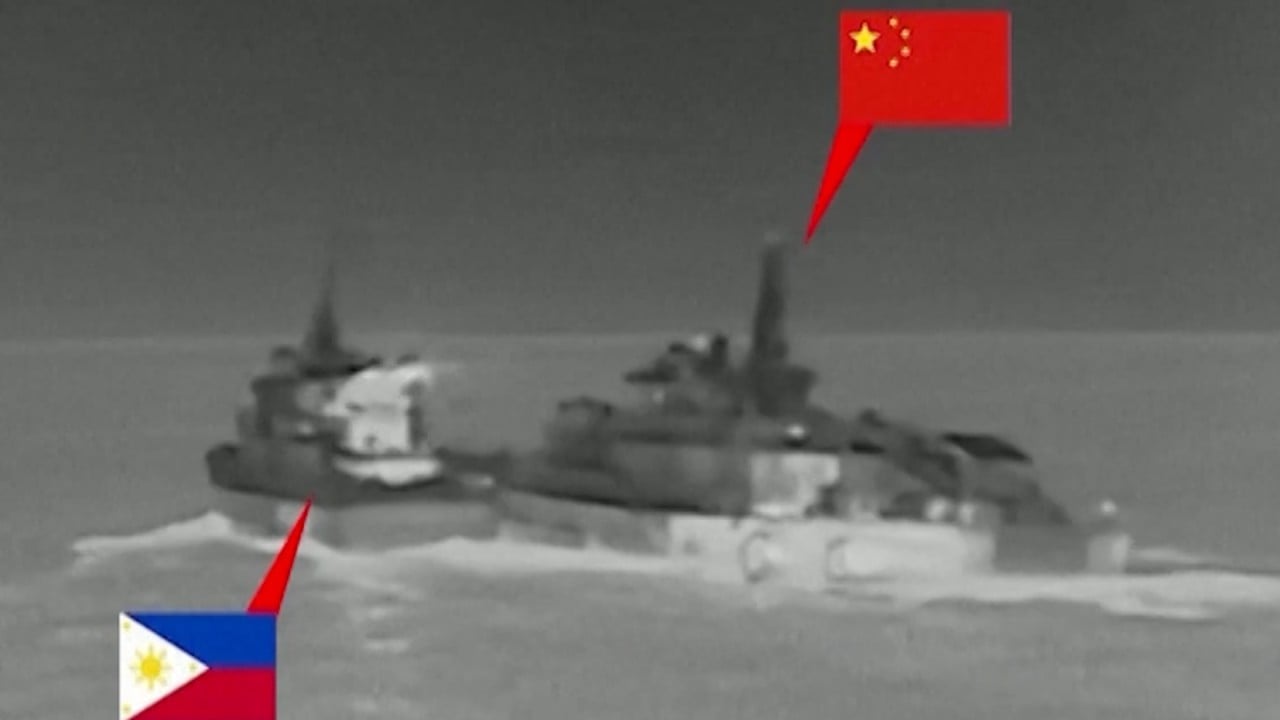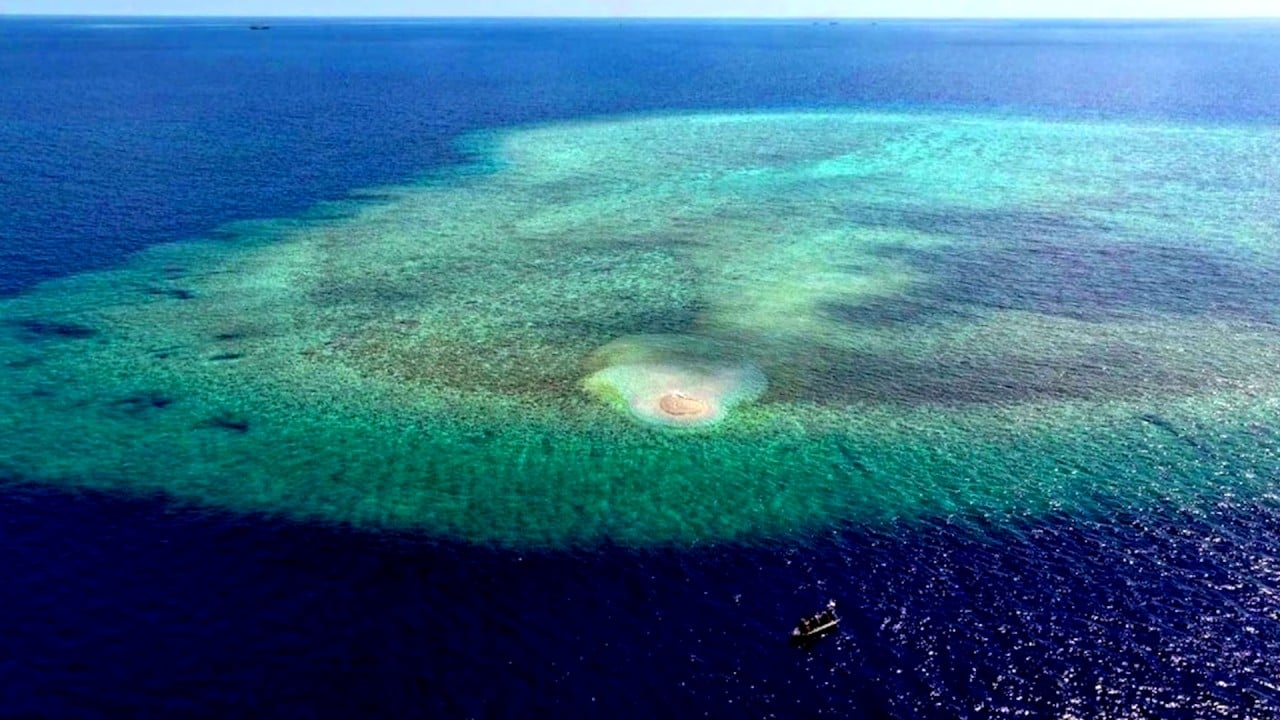Maritime analysts say clashes between the Chinese and Philippine coastguards near a South China Sea shoal could become more frequent and intense as the two countries vie for control of the atoll.
Two Philippine vessels on a resupply mission were damaged in a collision on Monday with a Chinese ship near Sabina Shoal, which is claimed by both countries but controlled by neither.
The shoal could have strategic value to the Philippines as a staging post to resupply troops on the Manila-controlled Second Thomas Shoal about 35 nautical miles (65km) further west in the Spratly Islands.
Known as Xianbin Reef in China and Escoda Shoal in the Philippines, Sabina Shoal has been a flashpoint since April, when Manila deployed one of its most advanced coastguard ships, the BRP Teresa Magbanua, to the nearby waters to monitor what it called Beijing’s illegal land reclamation activities at the atoll – an accusation Beijing denies.
China has deployed several vessels, including the 12,000-tonne CCG-5901 – the largest coast guard ship in the world – to the area to monitor the Philippine vessel, which could soon be relieved by another ship, the BRP Melchora Aquino, according to a Chinese think tank.
Observers said confrontations like the one this week were likely to recur, given the shoal’s strategic location of the reef, and its proximity to other disputed areas and energy resources.
“More acute and intense maritime confrontations are very likely to take place between Chinese and Philippine coastguards near the waters off Sabina Shoal, given the strategic value it holds for Manila’s resupply mission to Second Thomas Shoal,” said Ding Duo, deputy director of the Institute of Maritime Law and Policy at the National Institute for South China Sea Studies in Hainan.
Ding said Chinese coastguard ships and fishing boats would remain in force in the area as long as the Philippine coastguard vessel stayed.
He said Manila planned to use Sabina Shoal as a base for its resupply missions to the BRP Sierra Madre, an aging navy ship intentionally grounded at Second Thomas Shoal in 1999 to reinforce Manila’s territorial claims.
China also claims Second Thomas Shoal, a site of many confrontations between the two countries in the past year.
Ding said Chinese control of Sabina Shoal would “impose greater operational pressure” on Manila’s resupply boats as they would pass the nearby waters en route to Second Thomas Shoal, which is more than 100 nautical miles from the Philippine island of Palawan.
“The Philippines will not allow China to gain control over Sabina Shoal … If China were to effectively control it, it could potentially block Philippine supply ships from even approaching Second Thomas Shoal. Those resupply ships could be intercepted earlier at Sabina Shoal,” he said.
Collin Koh, a senior fellow at the S. Rajaratnam School of International Studies in Singapore, said Sabina Shoal would also be a useful shelter for Philippine supply ships.
“[If ships] bump into inclement weather, at least Sabina Shoal is a place where they could take refuge for a while before continuing the mission to Second Thomas Shoal, rather than trying to run all the way back to the island [of Palawan], which is quite a distance away,” he said.
Sabina was also critical to Manila’s energy security as it was near Recto Bank, or Reed Bank, an area about 85 nautical miles from Palawan that is believed to have substantial reserves of oil and natural gas, Koh said.
In April, retired Philippine Supreme Court senior associate justice Antonio Carpio said the country needed to defend Sabina Shoal from potential Chinese construction because it could affect the Philippines’ energy security for decades.
Carpio told Philippine broadcaster GMA Network that the gas reserves at the bank could potentially meet the country’s energy needs for up to 75 years.
Koh said Sabina Shoal was “certainly valuable for the Philippines as it has been looking at prospecting South China Sea energy resources for its long-term energy security needs”.
But Manila’s attempts to extract resources could face challenges, as Beijing might “monitor and potentially intercept these activities” if it established a presence on the shoal, he said.
Instead of running a vessel aground for anchoring it there, Manila might aim to “put up a consistent maritime presence” near the shoal, enabling it to rotate its available offshore patrol vessels in and out of the area throughout the year, he said.
“Their purpose is to assert effective administration [over Sabina Shoal], so at least they wouldn’t concede the feature to China.”
Koh said Manila wanted to avoid a repeat of the 2012 Scarborough Shoal incident, where Beijing ultimately assumed unilateral control of the shoal – a situation that continued to “haunt Manila”.
But Ding said Beijing would “not allow the permanent presence of a Philippine coastguard ship at Sabina Shoal”.
“The Philippines must steer clear of action that could provoke tensions. By unilaterally advancing its interests on Sabina Shoal, it invites not only challenges from China but also deepens its own predicaments,” he said.
“Both nations might find themselves trapped in a difficult situation, compelled to tackle these thorny matters, which could, in turn, ratchet up tensions.”
Koh said there were two situations when Beijing might try to head off Manila: during a changeover of Philippine patrol vessels stationed on Sabina Shoal or during a resupply mission to coastguard vessels in the area.
“If China pushes the envelope too much, then the Philippines might potentially consider something that is up the escalation ladder – meaning it might involve its navy, or it might potentially involve extra-regional help, for example, the United States,” Koh said.
Any face-offs “could turn very ugly”, he said.




